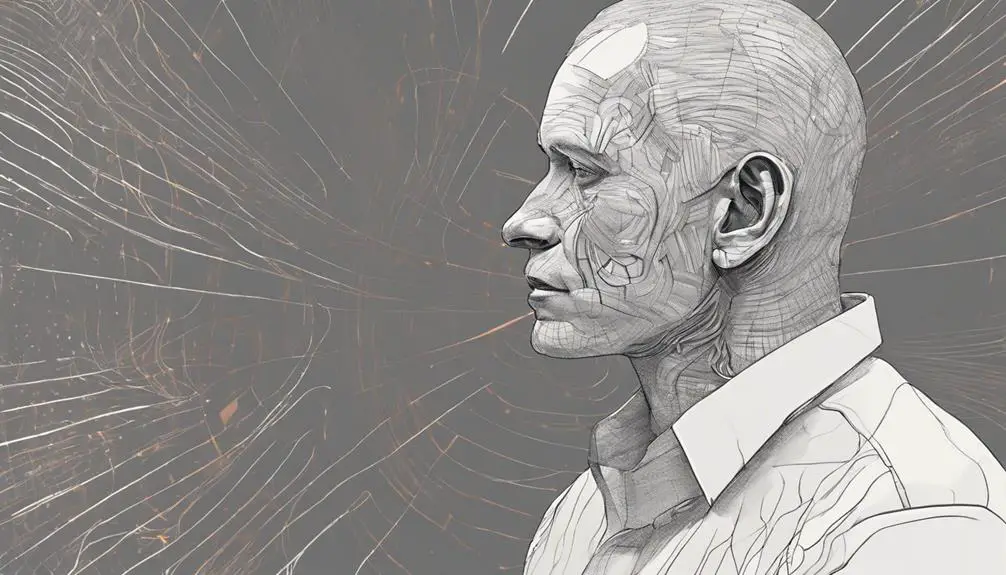Hypnosis Induction Techniques
Effortless NLP Techniques to Induce Hypnosis Quickly
November 4, 2021 - Hypnosis Induction Techniques
Effortlessly inducing hypnosis through NLP involves building rapport, utilizing eye patterns, anchoring techniques, employing language patterns, and applying the Milton Model. Crafting a harmonious relationship with active listening and empathy, observing eye movements, and utilizing anchors linked to desired mental states can enhance hypnotic induction. Hypnotic storytelling, ambiguous phrases, and the Milton Model's vague language can influence the subconscious mind effectively. Mastering linguistic techniques and using hypnotic phenomena like catalepsy and amnesia can quicken the induction process. Enhance your skills in inducing hypnosis by mastering these techniques.
Establishing Rapport

Establishing rapport is a foundational step in utilizing NLP techniques for hypnosis, as it lays the groundwork for effective communication and trust between the hypnotist and the subject. Building trust is essential in hypnosis as it creates a safe space for the subject to relax and be receptive to suggestions.
To establish rapport, active listening is paramount. The hypnotist must attentively listen to the subject, not only to understand their words but also to grasp their emotions and non-verbal cues. By demonstrating genuine interest and empathy through active listening, the hypnotist can forge a stronger connection with the subject.
Moreover, active listening fosters a deeper understanding of the subject's thought patterns, language preferences, and sensory modalities, which are crucial for tailoring NLP techniques effectively. It also helps in identifying the subject's communication style, enabling the hypnotist to adapt their language and pace to enhance rapport further.
Ultimately, building trust through active listening sets the stage for successful hypnosis sessions by creating a harmonious relationship between the hypnotist and the subject.
Utilizing Eye Patterns
Understanding and leveraging eye patterns is a strategic element in the application of NLP techniques for hypnosis. Eye contact plays a crucial role in establishing rapport and influencing the hypnotic process. By observing a person's eye movements, a hypnotist can gain insights into their thought processes and emotional states.
Mirroring the eye movements of the individual can enhance rapport and create a deeper connection, facilitating the induction of hypnosis.
Blink frequency is another aspect to consider when utilizing eye patterns in hypnosis. Rapid blinking may indicate nervousness or internal conflict, while slow blinking can suggest relaxation and receptiveness to suggestions. By paying attention to blink frequency, a hypnotist can adjust their approach accordingly to guide the individual into a deeper hypnotic state.
Gazing techniques, such as maintaining steady eye contact or using soft, unfocused gazes, can help establish a trance-like state conducive to hypnosis. These techniques, combined with mirroring and interpreting blink frequency, form a powerful toolset for inducing hypnosis effectively through eye patterns.
Anchoring Techniques

Anchoring techniques play a pivotal role in solidifying positive associations and conditioning responses during the hypnosis process. By utilizing body language and subconscious triggers, practitioners can create powerful anchors that help induce and deepen hypnotic states.
Body language, such as a gentle touch on the shoulder or a specific hand gesture, can serve as physical anchors that link to a desired mental state. These physical cues become associated with the hypnotic trance, allowing the individual to access that state more readily in the future.
Subconscious triggers, on the other hand, involve using specific words, sounds, or visual cues to evoke a particular response. Through repetition and reinforcement, these triggers become ingrained in the subconscious mind, enabling quicker access to the desired hypnotic state.
Using Language Patterns
Utilizing specific language patterns is a strategic method employed in hypnosis to influence the subconscious mind and guide individuals towards desired mental states. Through hypnotic storytelling and conversational hypnosis, practitioners can weave narratives that bypass the critical faculties of the conscious mind, allowing suggestions to penetrate deeply into the subconscious.
The power of suggestion plays a pivotal role in this process, as subtle language cues, tonality, and pacing can elicit profound responses from the hypnotized individual.
Hypnotic language is characterized by the use of ambiguous phrases, embedded commands, and presuppositions that create a sense of certainty and authority in the hypnotist's words. By skillfully crafting language patterns that engage the imagination and trigger emotional responses, hypnotists can lead individuals into trance states where they are more receptive to positive suggestions and therapeutic interventions.
Mastering the art of using language patterns in hypnosis requires a deep understanding of linguistic structures, psychological principles, and the dynamics of human communication. When employed effectively, hypnotic language can facilitate profound transformations in individuals' beliefs, behaviors, and perceptions, leading to enhanced well-being and personal development.
Employing Milton Model

A key aspect of utilizing advanced language patterns in hypnosis involves employing the Milton Model to induce trance states and facilitate therapeutic change in individuals.
The Milton Model, named after the famous hypnotherapist Milton H. Erickson, focuses on using hypnotic language, effective communication, persuasive techniques, and subconscious influence to guide individuals into altered states of consciousness where therapeutic interventions can occur.
This model utilizes vague language, metaphors, storytelling, and open-ended suggestions to bypass the conscious mind and communicate directly with the subconscious. By doing so, the Milton Model can help individuals relax, access their inner resources, and make positive changes at a deeper level of awareness.
Practitioners of hypnosis often find the Milton Model to be a powerful tool for creating rapport, inducing trance, and delivering suggestions that are more readily accepted by the subconscious mind, leading to profound therapeutic outcomes.
Creating Trance States
Inducing trance states in hypnosis involves strategically guiding individuals into a heightened state of focused attention and suggestibility. Deep relaxation is a fundamental aspect of creating trance states, as it helps individuals let go of physical and mental tension, allowing them to enter a more receptive state. Techniques such as progressive muscle relaxation, controlled breathing exercises, and visualization can aid in achieving deep relaxation, paving the way for a more profound hypnotic experience.
Moreover, rapid induction methods can be employed to quickly induce trance states in hypnosis. These techniques aim to bypass the critical conscious mind and directly access the subconscious. Techniques like the handshake interrupt, rapid eye fixation, or confusion techniques can swiftly guide individuals into a trance state, enhancing suggestibility and responsiveness to hypnotic suggestions.
Applying Hypnotic Suggestions

Implementing tailored hypnotic suggestions involves strategically crafting language patterns to influence subconscious responses and behaviors in individuals under hypnosis. To deepen relaxation during hypnosis, suggestions can be made to help the individual let go of tension in their muscles, slow down their breathing, and enter a state of profound calmness.
By incorporating phrases like 'You are sinking deeper into relaxation with every breath you take' or 'Feel the heaviness in your body as you drift into a peaceful state,' the hypnotist can guide the individual towards a heightened sense of tranquility.
Enhancing visualization is another essential aspect of applying hypnotic suggestions. By using vivid and descriptive language, the hypnotist can prompt the individual to imagine scenarios, places, or sensations with great detail.
Suggestions such as 'Picture yourself walking along a serene beach, feeling the warm sand beneath your feet' or 'Visualize a bright light filling you with positivity and energy' can help individuals create vivid mental images that deepen their hypnotic experience.
Frequently Asked Questions
Can Hypnosis Be Dangerous or Have Negative Side Effects?
Hypnosis, when conducted by a trained professional, generally poses low potential risks. Misconceptions and myths often surround hypnosis, but adverse effects are rare. Negative side effects, such as false memories or emotional distress, may occur in susceptible individuals.
How Can I Tell if Someone Is Faking Being Hypnotized?
Detecting deception in hypnosis involves observing subtle cues like inconsistent responses, lack of physiological changes, or exaggerated behaviors. Genuine hypnosis authenticity is characterized by a deep state of relaxation, focused attention, and responsiveness to suggestions.
Are There Ethical Considerations When Using Hypnosis Techniques?
Ethical considerations when using hypnosis techniques are paramount. Professional responsibility dictates ensuring informed consent, respecting boundaries, and prioritizing safety. Upholding these principles safeguards individuals and promotes trust in the practice of hypnosis.
Can Hypnosis Be Used to Retrieve Repressed Memories?
Hypnosis is a technique that some believe can aid memory recall. When used ethically and cautiously, it may assist in accessing repressed memories. In trauma recovery, hypnotherapy may provide a therapeutic avenue for exploration and healing.
Are There Age or Health Restrictions for Undergoing Hypnosis?
When considering hypnosis, age restrictions may apply due to cognitive development. Health considerations are crucial, with safety precautions necessary to minimize potential risks. A thorough assessment by a qualified professional is advised before undergoing hypnosis.
Conclusion
In conclusion, by employing a combination of rapport-building, eye patterns, anchoring techniques, language patterns, Milton Model, trance states, and hypnotic suggestions, individuals can induce hypnosis quickly and effectively.
These effortless NLP techniques provide a systematic approach to guiding individuals into a hypnotic state, allowing for deeper levels of suggestibility and potential therapeutic benefits.
It is crucial to practice and refine these techniques in order to master the art of inducing hypnosis with precision and proficiency.
